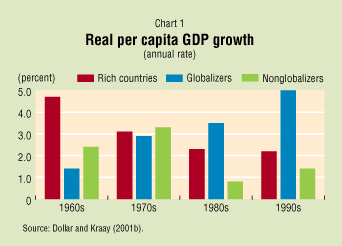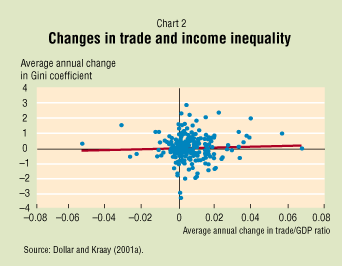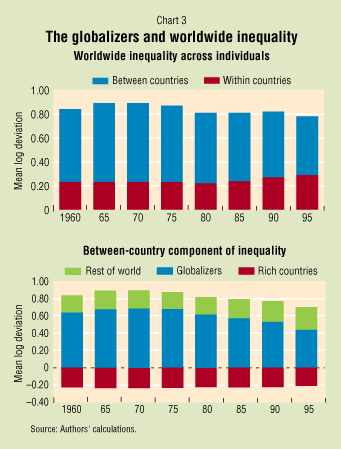 About F&D Subscribe Back Issues Write Us Copyright Information |
Trade, Growth, and Poverty David Dollar and Aart Kraay How has many developing countries' increased participation in international trade affected their economic growth rates, and what implications has this had for the international distribution of income and the incidence of poverty? The world has become a much smaller place over the past two decades. International trade has grown twice as fast as worldwide income during this period. Spurred by advances in information technology, a growing share of this trade is in services rather than merchandise, especially among rich countries. International direct and portfolio equity investment has also surged tremendously during the same period. What are the implications of international integration—or globalization—for inequality and poverty? In recent research (Dollar and Kraay, 2001b), we have explored this question by studying the experiences of a group of developing countries that have significantly opened up to international trade during the past two decades. We provide evidence that, contrary to popular beliefs, increased trade has strongly encouraged growth and poverty reduction and has contributed to narrowing the gaps between rich and poor worldwide.
Growth rates have increased Per capita GDP growth in the post-1980 globalizers accelerated from 1.4 percent a year in the 1960s and 2.9 percent a year in the 1970s to 3.5 percent in the 1980s and 5.0 percent in the 1990s (Chart 1). This acceleration in growth is even more remarkable given that the rich countries saw steady declines in growth from a high of 4.7 percent in the 1960s to 2.2 percent in the 1990s. Also, the nonglobalizing developing countries did much worse than the globalizers, with the former's annual growth rates falling from highs of 3.3 percent during the 1970s to only 1.4 percent during the 1990s. This rapid growth among the globalizers is not simply due to the strong performances of China and India in the 1980s and 1990s—18 out of the 24 globalizers experienced increases in growth, many of them quite substantial.
 Although these experiences are suggestive of the growth effects of trade, they are hardly conclusive. In recent research, we have studied the growth effects of trade more systematically using a large sample of developed and developing countries. Although a large body of literature has examined the effects of trade on growth (and many of these studies have found substantial growth effects of trade), this evidence has recently been subjected to criticism, most influentially by Rodriguez and Rodrik (2000).
In our recent research, we have attempted to address some of these concerns. In order to eliminate the geographically determined component of trade, we have estimated the effect of trade on growth using decade-over-decade changes in countries' trade as shares of their GDPs. This, by definition, removes the spurious effect of geography on trade and growth (because countries' geographic characteristics do not change over time) and, in our view, gives a cleaner (although still far from perfect) measure of the policy-induced component of trade. To control for the effects of other contemporaneous changes in policies and institutions that may affect growth, we included measures of the stability of monetary policy, financial development, and political instability. Finally, we use an econometric technique for which the results are less likely to reflect reverse causation running from growth to trade. The evidence that emerges from this analysis is consistent with the experiences of the post-1980 globalizers. We found a statistically significant and economically meaningful effect of trade on growth: an increase in trade as a share of GDP of 20 percentage points increases growth by between 0.5 and 1 percentage point a year. Inequality has not increased systematically Although the growth benefits of trade are increasingly recognized, many analysts are legitimately concerned about the effects of trade liberalization on income distribution. In our research, however, we document that the growth benefits of increased trade are, on average, widely shared—we have found no evidence of a systematic tendency for inequality to increase when international trade increases (see Dollar and Kraay, 2001a). Chart 2 illustrates this point by plotting changes in a measure of inequality (the Gini coefficient, which ranges from 0 to 100, with a higher coefficient indicating greater inequality) on the vertical axis, and changes in trade volumes on the horizontal axis. This figure reflects the experiences of more than 100 developed and developing countries, with changes in trade and changes in inequality measured over periods of at least five years in order to capture the medium-to-long-run relationship between trade and inequality. Chart 2 exhibits a striking absence of any simple correlation between changes in trade and changes in inequality. In our other research, we have examined the validity of this simple result in several dimensions. We considered a wide variety of measures of openness, including direct measures of trade policy and international capital flows, as well as trade volumes themselves. We also searched for nonlinearities in this relationship, allowing for the possibility that the effects of trade on inequality are different in rich and poor countries and in countries with different factor endowments. The conclusion that emerges from this—that there is little evidence of a systematic tendency for inequality to either increase or decrease with increased trade—is consistent with the simple evidence presented in Chart 2.
 This evidence is also consistent with the experiences of the post-1980 globalizers. While several of our globalizers have seen increases in inequality (most notably China, where the Gini coefficient increased from around 32 in the early 1980s to 40 in the mid-1990s), several others have seen decreases (for example, Malaysia, where the Gini coefficient fell from 51 to 48 during the same period). And, in many countries, large shifts in income distribution can arguably be linked to influences far removed from international trade. In China, for example, domestic liberalization, restrictions on internal migration, and agricultural policies have played a much larger role than increases in international trade. Poverty has declined The combination of increases in growth and little systematic change in inequality in the globalizers has considerably boosted efforts to reduce poverty. In Malaysia, for example, the average income of the poorest fifth of the population grew at a robust 5.4 percent annually. Even in China, where inequality did increase sharply and the income growth rate of the poorest fifth lagged behind average income growth, incomes of the poorest fifth still grew at 3.8 percent annually. The fraction of the population of these countries living below the $1 a day poverty threshold fell sharply between the 1980s and the 1990s: from 43 percent to 36 percent in Bangladesh, from 20 percent to 15 percent in China, and from 13 percent to 10 percent in Costa Rica, to name a few. Gap between rich and poor has narrowed We have already seen that income inequality within countries is as likely to decrease as increase with increased trade. But is globalization leaving poor countries behind and widening the gap between the richest and poorest countries? Our evidence on the growth performance of the globalizers relative to the rich countries and the nonglobalizing developing countries suggests otherwise. The rapid growth of the globalizers relative to the rich countries means that the globalizers are narrowing the per capita income gap. Moreover, because most of the globalizers—especially China, India, and Bangladesh—were among the poorest countries in the world twenty years ago, their growth has been a force for narrowing worldwide inequality. The top panel of Chart 3 provides a rough estimate of trends in worldwide inequality over the past forty years, using the mean log deviation measure of income inequality (the mean log deviation can be interpreted as the percentage difference between the income of a randomly selected "typical" individual and worldwide average income). To construct this figure, we used cross-country differences in real per capita GDP adjusted for differences in purchasing power for more than 100 countries as a measure of income differences between countries. To measure inequality within countries, we used the nearest available Gini coefficient for each five-year period for each country.
 Worldwide interpersonal inequality has been quite stable over the past forty years, showing at most a weak downward trend that is unlikely to be statistically significant, given the immense difficulties of measurement inherent in such calculations. More interesting for our purposes is the effect of the rapid growth of the post-1980 globalizers on this inequality measure. To illustrate this, the top panel of Chart 3 first divides worldwide inequality into inequality between countries and inequality within countries. Consistent with the findings of other studies, most worldwide interpersonal income inequality can be attributed to the large differences in average incomes between countries, rather than to inequities in the distribution of income within countries. And since many of the globalizers were initially poor, their rapid growth over the past twenty years has contributed to reducing income inequality between countries. This can be seen in the bottom panel of Chart 3, which takes the between-country component of inequality and further subdivides it into the globalizers, the rich countries, and the rest of the world. Much of the decline in the between-country component of inequality can be seen to be due to the rapid growth of the globalizers, most notably China and India, whose economies' vast size has given them substantial weight in these calculations. Conclusions The integration of the world economy over the past twenty years has been dramatic. The experiences of the post-1980 globalizers show that the process can have great benefits, contributing to rising incomes and falling poverty and enabling some of the poorest countries in the world to catch up with richer countries. The real losers from globalization are those developing countries that have not been able to seize the opportunities to participate in this process.
References:
———, 2001b, "Trade, Growth, and Poverty," World Bank Policy Research Department Working Paper No. 2615 (Washington). This paper can also be found on the web at http://www.worldbank.org/ research/growth. Francisco Rodriguez and Dani Rodrik, 2000, "Trade Policy and Economic Growth: A Skeptic's Guide to the Cross-National Evidence," in NBER Macro Annual 2000, ed. by Ben Bernanke and Kenneth Rogoff (Cambridge, Massachusetts: National Bureau of Economic Research).
|
|||||||||||